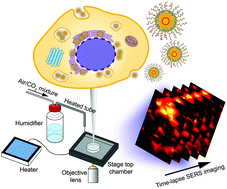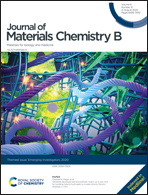Gap-enhanced resonance Raman tags for live-cell imaging†
Abstract
Surface-enhanced Raman scattering (SERS) nanotags are widely used in the biomedical field including live-cell imaging due to the high specificity from their fingerprint spectrum and the multiplexing capability from the ultra-narrow linewidth. However, long-term live-cell Raman imaging is limited due to the photodamage from a relatively long exposure time and a high laser power, which are needed for acquiring detectable Raman signals. In this work, we attempt to resolve this issue by developing ultrabright gap-enhanced resonance Raman tags (GERRTs), consisting of a petal-like gold core and a silver shell with the near-infrared resonant reporter of IR-780 embedded in between, for long-term and high-speed live-cell imaging. GERRTs exhibit an ultrahigh Raman intensity down to a single-nanoparticle level in aqueous solution and the solid state upon 785 nm excitation, allowing for high-resolution time-lapse live-cell Raman imaging with an exposure time of 1 ms per pixel and a laser power of 50 μW. Under these measurement conditions, we can possibly capture dynamic cellular processes with a high temporal resolution, and track living cells for long periods of time owing to the reduced photodamage to cells. These nanotags open new opportunities for ultrasensitive, low-phototoxic, and long-term live-cell imaging.

- This article is part of the themed collection: Journal of Materials Chemistry B Emerging Investigators


 Please wait while we load your content...
Please wait while we load your content...